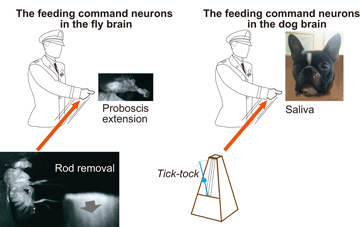Highlights
-
Unravelling what is going on in the brain during Pavlovian conditioning
-
Alteration in information processing by feeding command neurons governs behavioral change during Pavlovian conditioning
-
The established experimental system of Pavlovian conditioning made possible real-time observation of cell-cell connection for memory formation
Abstract
The group lead by Executive Researcher, YOSHIHARA Motojiro, and Senior Researcher, SAKURAI Akira, at the National Institute of Information and Communications Technology, Kobe (NICT, President: TOKUDA Hideyuki, Ph.D.) unraveled a neural correlate of Pavlovian conditioning. The feeding command neuron, which was discovered by the same group in the brain of fruit flies (Nature, 2013)1, was found to be hijacked by an originally-independent stimulus, leading to the conditioned response. Furthermore, the experimental system of Pavlovian conditioning made possible real-time observation of cell-cell connection for memory formation.
These results were published in Current Biology at 11 AM on August 4 (US Eastern Standard Time) in 2021.
Achievements
We unraveled a neural correlate in the brain during Pavlovian conditioning as one representative example of memory formation.
Although Pavlovian conditioning, where sound stimulus and food stimulus are associated, is widely known, its mechanism in the brain has been poorly understood. We took advantage of a fruit fly, Drosophila melanogaster, which allows us to monitor or manipulate activity of specific cells through genetic techniques. We also used an experimental system, which we have developed for simultaneous observation of both brain and behavior2, and tracked changes in the fly brain during Pavlovian conditioning.
We discovered that change in information processing by the feeding neuron, a pair of feeding command neuron3 in the Drosophila brain, governs Pavlovian conditioning. The feeding neuron is originally activated in response to food signals. However, rod removal, akin to using sound stimulus to a dog, activated the feeding neuron after repeating association of rod removal and feeding to the fly. We speculate putative feeding command neurons may be activated by the sound stimulus through newly formed connections during Pavlovian conditioning of a dog (See Figure 1). Furthermore, the experimental system of Pavlovian conditioning made possible real-time observation of cell-cell connection for memory formation.
Future plan
We are now observing formation of engram, which is responsible for memory, as a newly formed cell-cell connection in real-time. We will then try to test a general model of memory formation, the local feedback model, we have proposed (Science, 2005)4 by taking advantage of this experimental system to elucidate mechanism of memory.
Published paper
Journal: Current Biology
DOI: 10.1016/j.cub.2021.07.021
Title: Alteration in information flow through a pair of feeding command neurons underlies a form of Pavlovian conditioning in the Drosophila brain
Authors: Akira Sakurai, J. Troy Littleton, Hiroaki Kojima, and Motojiro Yoshihara
References
1. Flood, T., Iguchi, S., Gorczyca, M., White, B., Ito, K. and Yoshihara, M. Nature (2013) 499: 83-87.
2. Yoshihara, M. Journal of Visualized Experiments (2012) 62: e3625.
3. Yoshihara, Motojiro and Yoshihara, Motoyuki J. Neurogenet. (2018) 32: 53-62. Introduced by Nature (Nature, 558: 162, 2018).
4. Yoshihara, M.*, Adolfsen, B., Galle, K.T. and Littleton, J.T. Science (2005) 310: 858-863.

 nict.go.jp
nict.go.jp